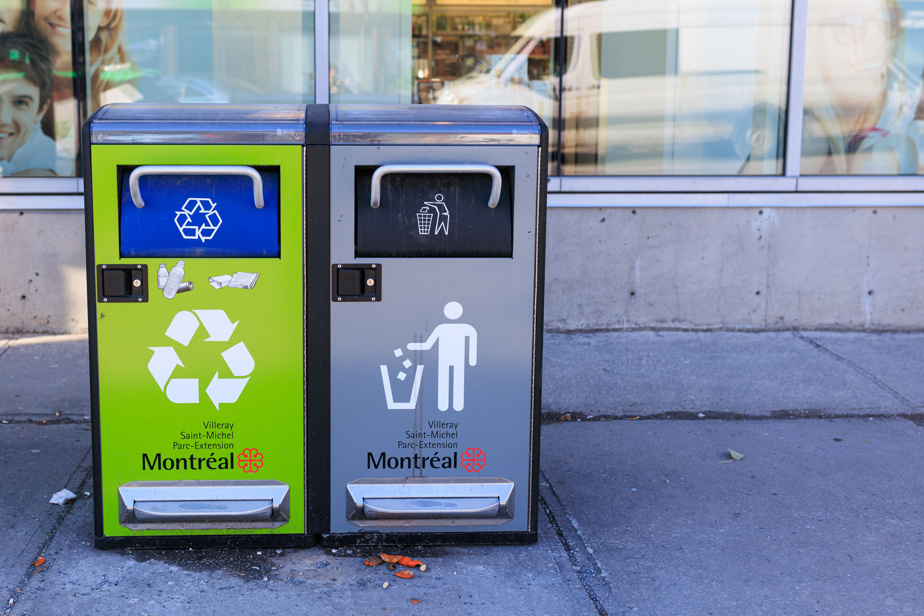“Smart trash cans” were supposed to improve waste collection on Montreal’s commercial streets. But the first borough to adopt them gave up, believing that these trash cans, which cost between $10,000 and $15,000 per pair, were not worth it. Which does not prevent other districts from continuing to buy them.
These bins installed in pairs to collect garbage and recyclable items, which compact the materials and send a signal when they are full, have a capacity five times greater than traditional equipment. They were supposed to save money by reducing the frequency of collections.
But according to the South-West district, which was the first to buy 58 of these smart bins from the BigBelly brand since 2017-2018, “few savings have been made to date”, despite an invoice of 475,000 $. The compaction system and the signal indicating the filling level operate using solar panels.
“Given the high cost of the purchase, we have not acquired new smart trash cans since and do not plan to add on. At the next breakage, they will be removed and replaced by conventional baskets,” indicates, in a written response, the district’s communications manager, Marie-Noëlle Hébert.
Since 2017, 13 pairs of BigBelly bins have been “damaged” and removed from the borough’s pavements, but Mme Hébert is not able to specify whether they were hit by machinery or whether they experienced operating problems. Seven of these trash cans were shown recently on the show Infoman at Radio-Canada, in a warehouse where they are kept in case certain parts are needed for repairs.
An unused function
You should know that the alert function, which allows you to know when these bins need to be emptied, is not used by the South-West, which prefers to empty them at the same time as the ordinary bins located on the same route. The district says it tested it, but noticed, over the years, that the function did not fit well with reality in its sector.
The only advantage: using the compaction system makes it possible to avoid a second collection in very busy areas and thus save time, emphasizes M.me Hébert.
The South-West is the district which has installed the greatest number of smart bins, but its mixed results do not seem to have been transmitted to the other districts.
Recently, BigBelly duos have appeared elsewhere:
- 8 in Rosemont–La Petite-Patrie since 2019;
- 4 in Ahuntsic–Cartierville in 2023;
- 13 in Anjou in 2023;
- 5 in Villeray–Saint-Michel–Parc-Extension in October 2023.
In other districts, garbage collectors only come when the trash cans send the signal that they need to be emptied.
This is the case in Anjou, where the installation was done eight months ago. “We have not yet compiled statistical data, but the first observations on the ground demonstrate real gains. The collection frequencies are much further apart and employees only move when they receive the signal that they must be emptied,” indicates Annie Laroche, spokesperson for the borough, in a written response. “We have also noticed noticeable improvements in cleanliness around trash cans located in busier areas, as they do not overflow. »
Villeray–Saint-Michel–Parc-Extension, which has recently been using these bins, also uses the alert function. “We only collect if necessary. Thanks to the load indicator, when an employee passes by and sees the bin half full, he does not empty it,” explains Benjamin Puji, head of the roads division for the district, who is the only one to have accepted to give us an interview on this subject.
However, as in the South West, employees rarely use the remote signal function to know the filling level, reveals Mr. Puji. In any case, collection trucks crisscross the streets to empty the 350 bins in the district, every day on the main roads. Garbage collectors can therefore make observations during their visit, he notes.
“We are still at the beginning of our experimentation, we are always looking for ways to better serve our customers,” concludes Mr. Puji.
WHAT IS A SMART TRASH?
Smart trash cans from the American brand BigBelly include a system for compacting garbage and recyclable materials. The largest models can hold five times more than normal municipal trash cans.
This system runs on solar energy, thanks to sensors located on the top of the trash cans. Their installation therefore does not require electrical infrastructure.
The bin indicates its filling level with a flashing light which changes from green to yellow, then to red.
It also communicates remotely to allow collection teams to know when it needs to be emptied.
